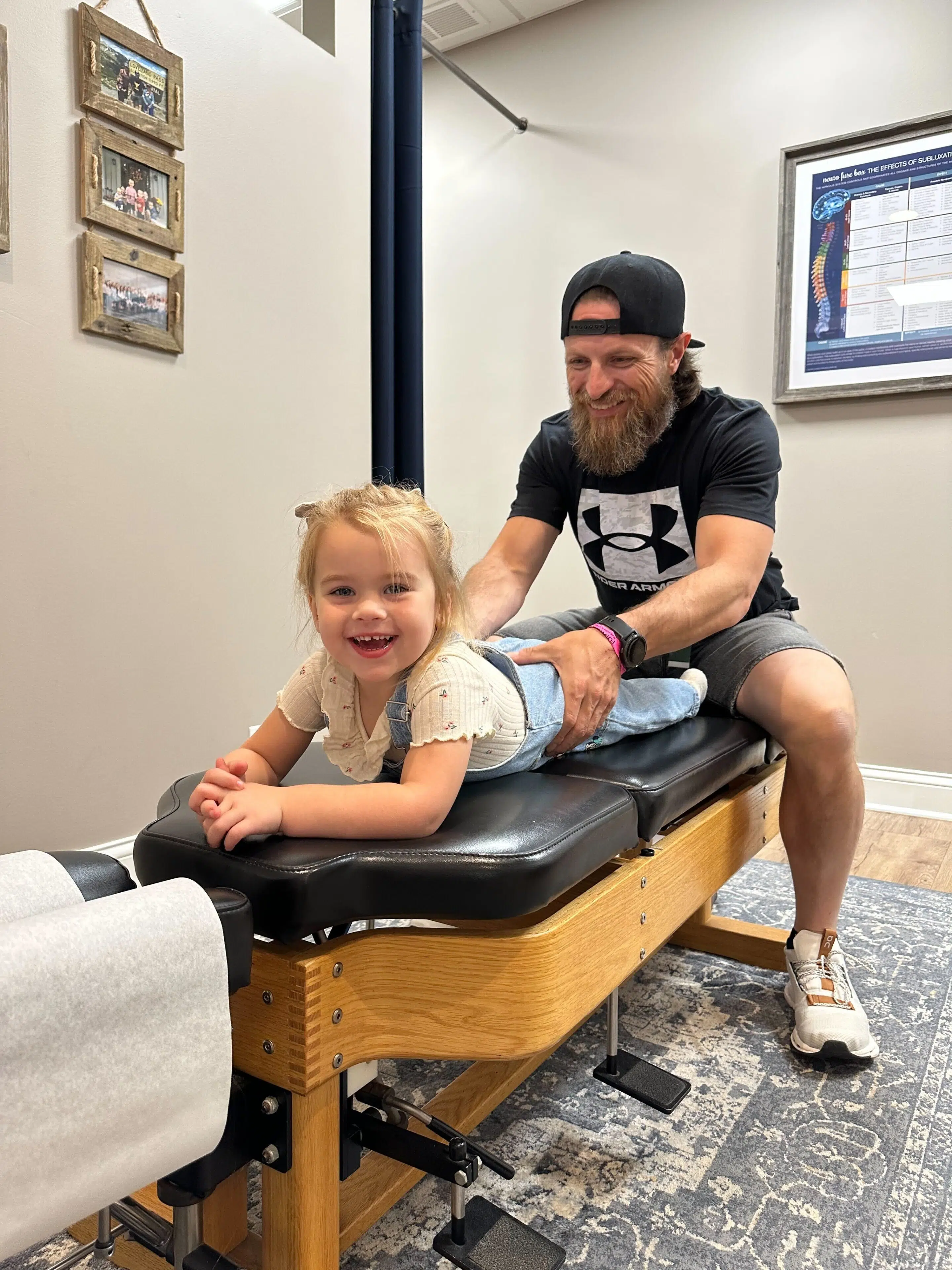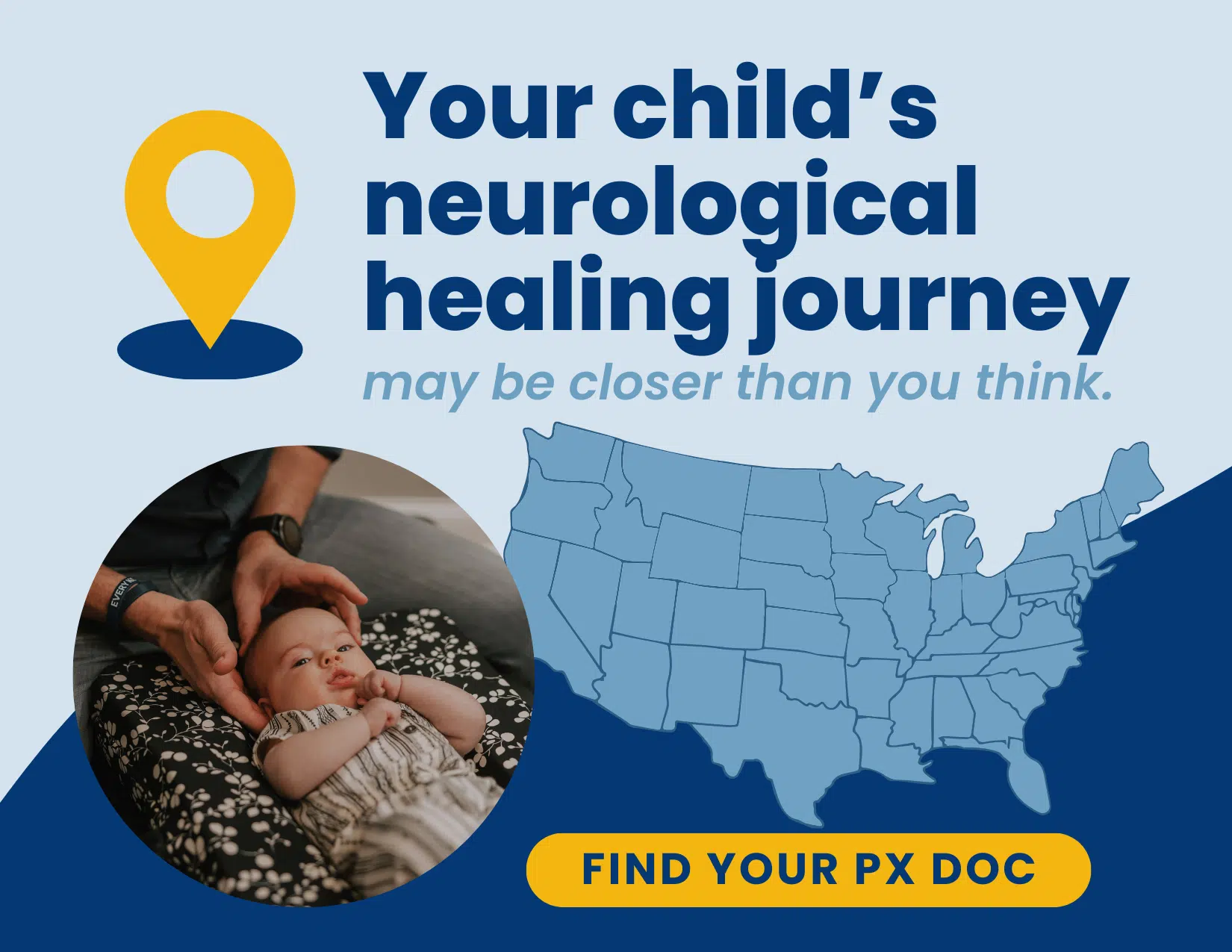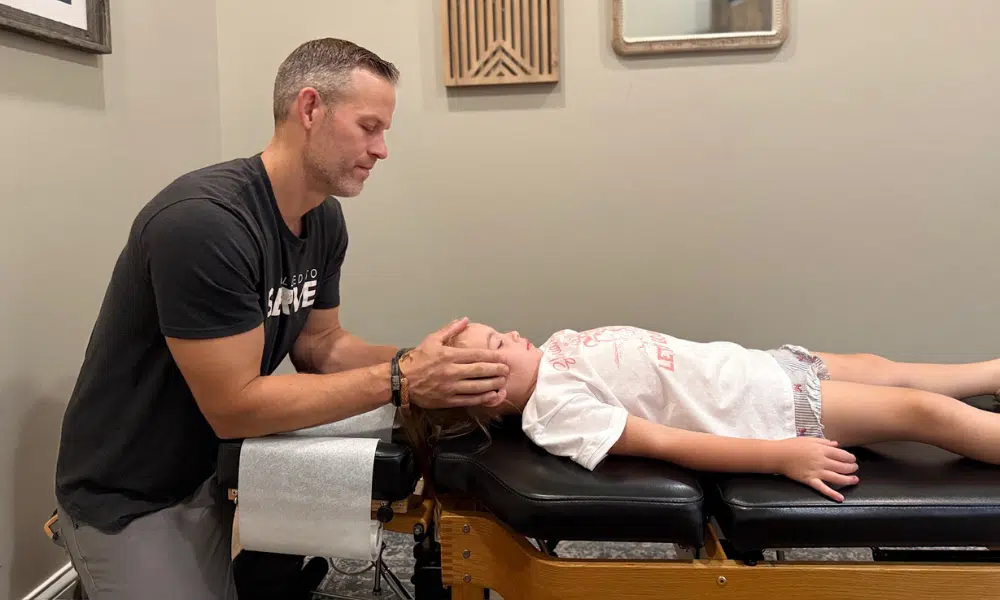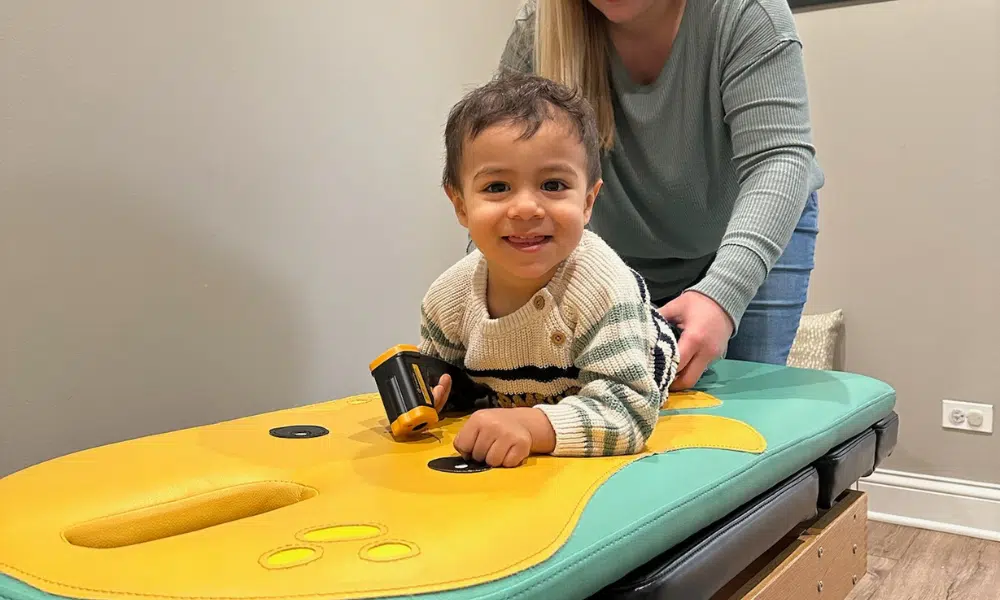When we first met Nolan, he struggled immensely with gross motor skills, nonverbal speech, and sensory and motor planning. At just 2 years old, he had recently been diagnosed with autism, and his developmental delays were not only affecting his current quality of life but also painting a challenging picture for his future. Despite his early intervention therapies, Nolan had plateaued and stopped making progress.
Nolan’s story is not uncommon. According to the CDC, approximately 1 in 6 children in the United States has a developmental disability or delay. These delays can manifest in various areas, including motor skills, speech and language, social and emotional development, and cognitive abilities.
We understand the frustration and heartbreak parents feel when their child is struggling to meet developmental milestones. We also recognize that the conventional medical approach to developmental delays often falls short, and that while traditional therapies like PT, OT, Speech, and Developmental Therapy help in so many ways, often it feels like there is still a “foundational” piece missing.
In this article, we’ll dive deeper into the world of developmental delays, exploring the different types, causes, and signs. Most importantly, we’ll share how PX Docs’ unique approach has helped countless children like Nolan break through “stuck” points and plateaus, and unlock their full potential and thrive.
If you’re a parent seeking answers and hope for your child’s developmental journey, read on to discover the life-changing power of Neurologically-Focused Chiropractic Care for children struggling with developmental delays.
Understanding Developmental Delays
Developmental delays refer to significant lags in a child’s ability to reach key milestones in one or more areas of development compared to their peers. These milestones serve as important markers of a child’s growth and progress in various domains, including motor skills, language and communication, social and emotional functioning, and cognitive abilities.
It’s important to note that while there are general timeframes for reaching developmental milestones, every child develops at their own pace. However, when a child consistently fails to meet milestones or shows a significant gap in their skills compared to age expectations, it may indicate a developmental delay.
Child developmental delays can manifest in several key areas:
- Gross Motor Delays: Gross motor delays affect a child’s ability to perform age-appropriate physical tasks, such as crawling, walking, or grasping objects. These delays impact both gross motor skills (larger movements involving arms, legs, and trunk) and fine motor skills (smaller, more precise movements of the hands and fingers). Motor delays are estimated to affect 12-16% of children under 6 years old.
- Speech and Language Delays: Children with speech and language delays may struggle with understanding or expressing language, including reaching milestones like babbling, saying first words, or forming phrases. Difficulties may also appear in nonverbal communication, such as gestures and facial expressions. Approximately 5-12% of preschool-aged children experience speech and language delays.
- Social, Emotional, and Behavioral Delays: Delays in social and emotional development can affect a child’s ability to interact, express and regulate emotions, and engage in appropriate play and behaviors. They may struggle with eye contact, responding to social cues, or adapting to new situations. Approximately 17% of children experience social, emotional, and behavioral delays.
- Cognitive Delays: Cognitive delays involve challenges in thinking, learning, and problem-solving skills, affecting memory, attention, reasoning, and basic concept understanding. These delays impact a child’s ability to learn and perform in school. Cognitive delays are estimated to occur in about 1-3% of children.
It’s worth noting that in 2022, the CDC made significant revisions to its developmental milestones checklists. These changes aimed to identify delays earlier and emphasize the importance of acting quickly when concerns arise.
However, it’s crucial to remember that the sequence and order in which children reach milestones are just as important as the timing. Skipping key milestones, such as crawling, can have a significant impact on a child’s overall development.
Crawling Is Essential to Development
Crawling is a pivotal developmental milestone for infants, crucial for enhancing motor coordination, cognitive skills, and neurological development. As infants learn to crawl, they develop bilateral coordination, using both sides of their body in a synchronized way, which fosters the creation of neural pathways between the brain’s hemispheres. This activity not only strengthens the muscles needed for future physical milestones like standing and walking but also enhances hand-eye coordination and visual-spatial awareness by requiring the infant to navigate and interact with their environment.
Moreover, crawling plays a significant role in cognitive and sensory integration. It challenges infants to solve problems, such as navigating towards desired objects or around obstacles, and exposes them to various sensory experiences that are essential for efficient sensory processing. This stage of development also promotes independence and emotional resilience, as gaining mobility allows infants to explore and engage more fully with the world around them.
Encouraging crawling can therefore support a host of developmental benefits, from physical conditioning and coordination to cognitive, emotional, and neurological growth. While some children may skip crawling and may not immediately present with apparent issues, it’s important for parents to take note of this and keep a close eye on sensory development, motor tone and coordination, and cognitive development down the road.
By understanding the various types of developmental delays and their potential impact on a child’s life, parents and caregivers can be better equipped to identify concerns for early intervention and seek appropriate support.
The “Perfect Storm” in Developmental Delays
When a child is experiencing developmental delays, parents often search for answers and explanations. The conventional medical perspective tends to still only focus on factors such as genetics and “bad luck” as primary causes of developmental delays. While some children have legitimate genetic disorders and those can certainly play a role, we now understand that the majority of developmental delays in children are caused by a combination of environmental factors and early exposures to certain stressors, injuries, and toxicity that adds up and overwhelms the nervous system, throwing it off track developmentally.
This complex interplay of various early childhood stressors can negatively impact a child’s developing nervous system, and unfortunately much of it goes unnoticed and undetected by the conventional pediatrician and even other early childhood specialists.
We call this the “Perfect Storm” concept—a combination of fertility and prenatal stress, birth trauma, and early exposure to toxins, antibiotics, and other chemicals that can lead to subluxation, nervous system dysregulation, and dysautonomia, creating the foundation for developmental delays.
Fertility Challenges, Prenatal Stress, and Maternal Health
The journey of child development begins long before they are born. In fact, recent research has emerged showing that fertility challenges and interventions such as IVF are linked to developmental delays and conditions such as autism. Not only are there neurophysiological effects to the developing child from the medications and interventions, but these also tend to be very high-stress and high-risk pregnancies, which have been linked to developmental delays as well.
During pregnancy, the mother’s health and well-being can have a significant impact on the developing fetus. Maternal stress, anxiety, and other emotional challenges can affect the intricate dance of hormones and neurotransmitters that shape the growing baby’s brain and nervous system. Put simply, if a mother’s nervous system is perpetually stuck in sympathetic fight-or-flight mode and overdrive, then that is the neurological environment the child’s brain and nervous system develop in during these critical and sensitive periods of development.
Research has shown that high levels of prenatal stress can increase the risk of developmental delays and other neurological challenges in children. When a mother experiences chronic stress, her body releases cortisol and other stress hormones that can cross the placenta and impact the fetus. This exposure can alter the development of key brain structures and pathways, setting the stage for potential delays down the road.
Birth Trauma and Interventions
The process of birth itself can also play a crucial role in a child’s developmental journey. Interventions such as forceps, vacuum extraction, induction, and cesarean sections are often life-saving, but can also lead to unintended consequences.
These interventions can cause physical stress and trauma to the delicate tissues of the baby’s head, neck, and spine. This trauma can result in subluxations—misalignments and tension in the nervous system that can interfere with proper communication between the brain and body, leading to nervous system dysfunction and dysregulation. When left unaddressed, subluxations and nervous system imbalance (dysautonomia) can contribute to a wide range of developmental challenges, from motor delays to sensory processing issues.
Early Childhood Stressors and Environmental Factors
The “Perfect Storm” doesn’t end at birth. As infants and young children navigate the world around them, they can encounter various stressors and environmental factors that further impact their developing nervous systems. These may include:
- Exposure to toxins and pollutants
- Nutritional deficiencies and imbalances
- Physical or emotional trauma
- Chronic illnesses or infections
- Overuse of antibiotics and other medications
Each of these factors can contribute to the overall stress load on a child’s body and brain, exacerbating any underlying subluxations and dysautonomia.
The Role of Subluxation and Dysautonomia
The interconnected web of subluxation and dysautonomia lies at the heart of the “Perfect Storm” concept. Subluxation, as mentioned earlier, are areas of neurological dysfunction that disrupt the flow of communication between the brain and body, especially with the neuromuscular and sensorimotor systems, which are crucial for overall brain and nervous system development.
When these subluxations occur in the upper neck, brainstem, and neurospinal regions, they can have a particularly profound impact on child development since those regions represent “Air Traffic Control” for the entire nervous system. This brainstem and neurospinal region are especially important for both gross and fine motor development, tone, and coordination, which are the essential building blocks for overall neurodevelopment.
The brainstem area also houses the reticular activating system, which plays a crucial role in regulating alertness, attention, and sensory processing. It also contains the origins of several cranial nerves, including the vagus nerve—a key player in the autonomic nervous system.
Dysautonomia, or imbalance in the autonomic nervous system, can occur when subluxations and other stressors disrupt the delicate balance between the sympathetic (“fight or flight”) and parasympathetic (“rest and digest”) branches. When the sympathetic nervous system becomes overactive and the parasympathetic nervous system becomes underactive, it can lead to a wide range of developmental challenges, from difficulty with self-regulation to sensory processing issues.
By understanding the complex interplay of factors that contribute to the “Perfect Storm” and the central role of subluxation, nervous system dysregulation, and dysautonomia, parents can begin to see the importance of addressing these underlying causes rather than simply managing traits. In the next section, we’ll explore the signs of developmental delays and how they can manifest in different areas of a child’s life.
Signs of Developmental Delays
Recognizing the signs of child developmental delays is crucial for parents and caregivers, as early intervention and identification can make a significant difference in a child’s long-term outcomes. While every child develops at their own unique pace, certain red flags may indicate the need for further evaluation and support.
It’s important to remember that the presence of one or two signs could indicate global developmental delay, but that isn’t always the case. However, if you notice a consistent pattern or cluster of concerns, it’s essential to trust your instincts and speak with your child’s healthcare provider.
Here are some common signs of developmental delays, organized by the main areas of development:
Motor Delays
Motor delays can affect both gross motor skills (larger movements involving arms, legs, and trunk) and fine motor skills (smaller, more precise movements of the hands and fingers). Some signs of motor delays include:
- Delayed milestones such as rolling over, sitting up, crawling, or walking
- Poor coordination or clumsiness
- Difficulty with fine motor tasks like grasping objects, using utensils, or buttoning clothes
- Weakness or low muscle tone
- Asymmetry in movements (using one side of the body more than the other)
Speech and Language Delays
Children with speech and language delays may have difficulty understanding or expressing language. Signs to look for include:
- Limited babbling or vocalizations in infants
- Not responding to their name or simple instructions
- Delayed first words or phrases
- Difficulty putting words together to form sentences
- Repeating words or phrases (echolalia) instead of constructing original sentences
- Trouble understanding or following verbal instructions
- Limited use of gestures or nonverbal communication
Social, Emotional, and Behavioral Delays
Delays in social and emotional development can impact a child’s ability to interact with others and regulate their emotions and behavior. Some signs may include:
- Limited eye contact or social engagement
- Difficulty with back-and-forth interactions or play
- Not showing interest in peers or shared activities
- Struggles with understanding or expressing emotions
- Intense or prolonged tantrums or meltdowns
- Rigidity or difficulty adapting to changes in routine
- Repetitive behaviors or interests that interfere with daily functioning
Cognitive Developmental Delays
Cognitive developmental delays can affect a child’s ability to think, learn, and problem-solve. Signs may include:
- Difficulty with basic concepts like colors, shapes, or numbers
- Struggles with memory or attention
- Slow to learn new skills or information
- Challenges with problem-solving or logical thinking
- Difficulty with imaginative or symbolic play
- Struggles with understanding cause-and-effect relationships
If you see any concerning signs in your child, it’s important to reach out to a healthcare provider or developmental specialist for evaluation and support. A significant delay in two or more developmental areas may indicate global developmental delay.
Remember, early intervention and identification are key to helping children with developmental delays reach their full potential. By staying attuned to your child’s unique development and advocating for their needs, you can set the stage for a brighter, more supported future.
The Role of Chiropractic Care in Addressing Developmental Delays
Neurologically-Focused Chiropractic Care plays a central role in PX Docs’ approach to helping children with developmental delays. Our Pediatric Chiropractors are specially trained to identify and address subluxation, nervous system dysfunction, and identify disruptions or delays in neurodevelopment that are often missed by other providers and even specialists.
For children experiencing developmental delays, this type of chiropractic care can be particularly beneficial not only on its own, but especially combined or integrated with other more commonly known developmental interventions such as physical therapy, occupational therapy, speech therapy, ABA, and so forth.
In fact, many times it’s not just parents seeking out chiropractic care themselves for their child’s developmental delays, but the referral is often made by other professionals who understand the role of subluxation and nervous system dysfunction, and know that they can experience better results through their interventions and therapies as well if the child is simultaneously under Neurologically-Focused Chiropractic Care.
Parents and pediatric providers alike often comment that chiropractic care was the missing “foundational link” in getting their child back on track developmentally and vastly improving their results and quality of life.
To learn more about how our PX Docs Clinical Process works, please visit this page.
Real-Life Results: Nolan’s Story
This is exactly what happened with Nolan, the young boy we mentioned at the beginning of this article.Before starting care at PX Docs, Nolan had plateaued in his progress. Despite various therapies and interventions, he continued to struggle with motor skills, speech, and sensory processing.
After a series of Neuro-Tonal adjustments, customized to his unique needs, Nolan began to make rapid progress. His coordination improved, his speech became clearer, and his ability to process sensory information grew by leaps and bounds.
Nolan’s story is just one of many we see at PX Docs. By addressing the root causes of developmental delays and supporting each child’s innate potential for healing and recovery, we help families unlock new possibilities and brighter futures.
Empowering Families to Help Their Children Thrive
We believe that parents and caregivers play a crucial role in their child’s developmental journey. That’s why we focus not just on providing care in our offices, but also on empowering families with the knowledge, tools, and resources they need to support their child’s progress at home.
Some of the ways we empower families include:
- Providing education on the role of the nervous system in development and how chiropractic care can help
- Offering guidance on creating a supportive home environment that promotes learning and growth
- Sharing tips and strategies for managing challenging behaviors or sensory sensitivities
- Collaborating with other healthcare providers and therapists to ensure a cohesive, multidisciplinary approach
- Celebrating each child’s unique strengths and progress, and helping families focus on the positive
By working in partnership with families, we create a supportive network that helps children with developmental delays thrive not just in our offices, but in all aspects of their lives.
The Power of Neurologically-Focused Chiropractic Care
If your child is struggling with a developmental delay, know that you are not alone—and that there is hope and something more that can be done! At PX Docs, we have seen countless children overcome challenges and reach new milestones thanks to the power of Neurologically-Focused Chiropractic Care.
By addressing the root causes of developmental delays—subluxation, dysfunction, and dysautonomia—our approach helps children unlock their ultimate potential for growth, development, and an optimal quality of life. We don’t just manage symptoms, we dive deep into nervous system dysfunction and the root cause of your child’s developmental delays.
If you’re ready to take the next step in your child’s developmental journey, we invite you to visit the PX Docs directory and find a qualified Pediatric Chiropractor near you. With compassionate care, cutting-edge technology, and a deep commitment to helping children thrive, PX Docs is here to support you every step of the way.
Together, we can help your child overcome developmental delays and unlock their full potential—one adjustment at a time.





